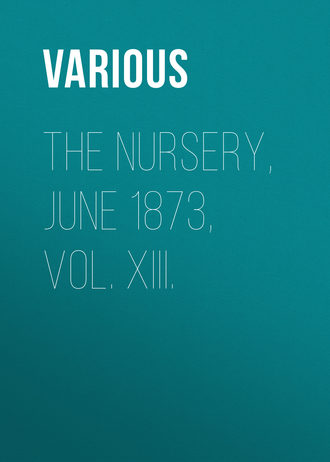
Various
The Nursery, June 1873, Vol. XIII.
DIXIE
Dixie, this little dog of mine,
Had legs like a spider, black and fine,
A nimble tail, and a body slim,
And ears that would almost cover him.
If you whispered to him of "birds" or "rats,"
Of "cows" or "squirrels" or "pigs" or "cats,"
He was all a-tremble with hope and fun,
Ready to hunt or fight or run.
But Dixie is older now; he shows
A gray mustache on his once black nose:
Slower his legs to frolic and leap;
And he needs a nice soft place to sleep.
But he has such brown and gentle eyes,
Has love so human, and ways so wise,
Has tastes so dainty,—the wilful elf!—
That he rules all things to suit himself.
Only Flora has any fear
If he speaks too loud, or comes too near;
Yet she told me bravely the other night
She could pat the end that didn't bite.
Clara Doty Bates.
ABOUT BEES
LOUDLY weeping, I ran to my father from the garden, a bee having stung me in the hand. He drew out the sting, washed my swollen hand in cool water, told me about those wonderful creatures the bees, and promised to take me to visit a gentleman who kept many hives of them.
So, the first fine day, we walked to a neighboring village, and found the bee-master, as he was called, very glad to show us his little pets. He first led us to a hive made wholly of glass, so that we might watch the bees at their labors.
He told us there were three kinds of bees; and in the picture you may see how they look, both when flying and when at rest. Those marked A are queen-bees; B are the male bees, or drones; and C the working-bees.
The most important bee in the hive is naturally the queen. She is longer and sleeker than the others, and has a crooked sting, of which, however, she seldom makes use. Similar in form, but smaller, are the working-bees, whose sting is straight. The male bee, or drone, is thicker than the others, and stingless.
"What has the queen to do in the hive?" I asked. The old gentleman replied, "She is the mother-bee, lays all the eggs, and is so diligent that she often lays twelve hundred in a day, having a separate cell for each egg. That is her only work; for she leaves the whole care of her children to the industrious working-bees, who have various labors to perform. Some of them build cells of wax; others bring in honey on the dust of flowers, called pollen; yet others feed and take care of the young; and a small number act as body-guard to the queen."
The bee-master next took us to a strange-looking old hive, and asked us what it was like. I said, "The trunk of a tree." He told me I was right, and that the wild bees still dwell in hollow trees.
He then showed us various kinds of hives, and, last of all, a glass globe, in which the bees had built a beautiful white comb in the form of a star, and filled it with honey. This he was to send as a wedding-present to a bride.
He said, "The bees can make of any egg, either a queen or a working bee, according to the food and treatment they give it. The queen requires but sixteen days in which to come to maturity; while the workers require twenty, and the drones twenty-four. When several queens appear at the same time, they fight until one gains the victory."
Honey is the nectar of flowers, which they collect with their tongues, place in their honey-bags, and deposit in cells built for the purpose, which, when filled, they cover with wax.
Bee-bread is made of the dust of flowers, with which the bee gets covered in collecting honey. This it brushes off, kneads into two little masses, which are placed in a sort of basket on the joint of the leg, where a fringe of hairs acts as a cover.
Wax is a secretion from honey, which oozes out between the rings which form the body, and is then worked with the mouth until it is fit for the construction of the comb. Bees also make a gummy substance for varnishing their cells, which they procure from the buds of trees.
When we took leave of the kind old gentleman, he gave me in a basket a nice honeycomb to take to my mother; and since that my father has bought me a hive of bees. Every summer I plant flowers in my garden for them, that they may not have far to go for their honey.


